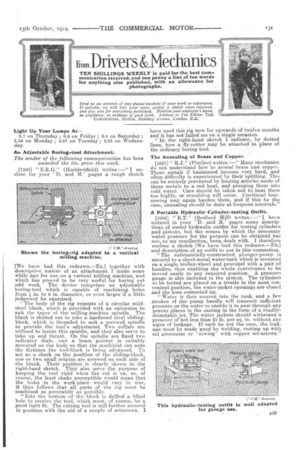' EOM Drivers &Mechanics
Page 21

If you've noticed an error in this article please click here to report it so we can fix it.
TEN SHILLINGS WEEKLY is paid for the best coin,. munication received, and one penny a line of ten words for anything else published, with an allowance for photographs.
Send us an account of any sPecial incident of your work or experience. If suitable, we will edit your notes, supply a sketch when required, and pay you for everything published.. Mention your employer's name, in confidence, as evidence of good faith. Address to The Editor, Tim COMMERCIAL MOTOR, Rosebery Avenue, LondonE.C.
Light Up Your Lamps At
6.7 on Thursday ; 6.6 on Friday ; 6.4 on Saturday ; 5.59 on Monday ; 5.57 on Tuesday ; 5.55 on Wednesday.
Alt Adjustable Boring-tool Attachment.
The sender of the following communication has been awarded the 10s. prize this week.
[1560] " E.R.G." (Huddersfield) writes :—" I enclose for your 'D. and M.' pages a, rough sketch
[We have had this redrawn.—En.] together with descriptive matter of an attachment I made some while ago for use on a vertical milling machine, and which has proved to be very useful for boring out odd work. The device comprises an adjustable boring-tool which is capable of machining holes from in. to 6 in. diameter, or even larger if a little judgment be exercised.
"The body of the rig consists of a circular mild
steel blank, which is provided with an extension to suit the taper of the milling-inachine spindle. The blank is slotted out to take a hardened steel slidingblock, which is threaded to suit a screwed spindle to provide the tool's adjustment. Two collars are utilized to locate this spindle, and they also serve to take up end thrust. On the spindle are fixed two indicator dials, and a brass pointer is suitably mounted on the body so that the machinist can note the distance the tool-block is being advanced. To act as a cheek on the position of the sliding-block, one or two small setpina are screwed on each side of the blank. Their position is clearly shown in the right-hand sketch. They also serve the purpose of keeping the tool rigid when the cut is on, as, of course, the least shake perceptible would mean that the holes in the work-piece would vary in size, it thus follows that all parts of the rig must be machined as accurately as possible.
"Into the bottom of the block is drilled a blind • hole to receive the tool, which must, of course, be a good tight fit. The cutting tool is still further secured iI1 position with the aid of a, couple of setscrews. I
have used this rig now for upwards of twelve months and it has not failed me on a single oCcasion.
" In the right-hand sketch I indicate, by dotted lines, how a fly-cutter may be attached in place of the ordinary boring tool.
The Annealing of Brass and Copper.
[1561] " B.X." (Pimlico) writes :--" Many Mechanics do not understand how to anneal brass and copper. These metals if hammered become very, hard, and often difficulty is experienced by their Splitting. This can be entirely prevented by heating articles made-of these metals to a red heat, and plunging them into cold water. Care should be taken not to heat them too highly, or crumbling will occur. Continual hammering may again harden them, and if this be the case, annealing should be done at frequent intervals."
A Portable HydraulicCylinder-testing Outfit.
[1564 " R.T." (Bedford Hill) writes :—" I have noticed in your D. and M.' pages many descriptions of useful hydraulic outfits for testing cylinders 'and pistons, but the means by which the necessary Water pressure for the purpose can be obtained has not, to my recollection, been dealt with. I therefore enclose a sketch [We have had this redrawn.—En.] and description of an outfit to use in this connection. "The substantially-constructed plunger-pump is secured to a Sheet-metal water-tank which is mounted on a single trolley-wheel and provided with a pair of handles, thus enabling the whole contrivance to be moved easily to any required position. A pressure gauge is also included in the system. The cylinders to be tested are placed on a trestle in the most convenient position, the water-jacket openings are, closed and the hose connected tip. "Water is then floured into the tank, and a few strokes of the pump handle will transmit sufficient pressure on the water to enable it to pass through any porous places in the casting in the form of a readilydetectable jet. The water jackets should withstand a pressure of not less than 25 lb. per sq. in. without any signs of leakage. If -swah be not the case, the leakage must be made good by welding, rusting up with sal ammoniac or ' sewing ' with copper set-screws."






















